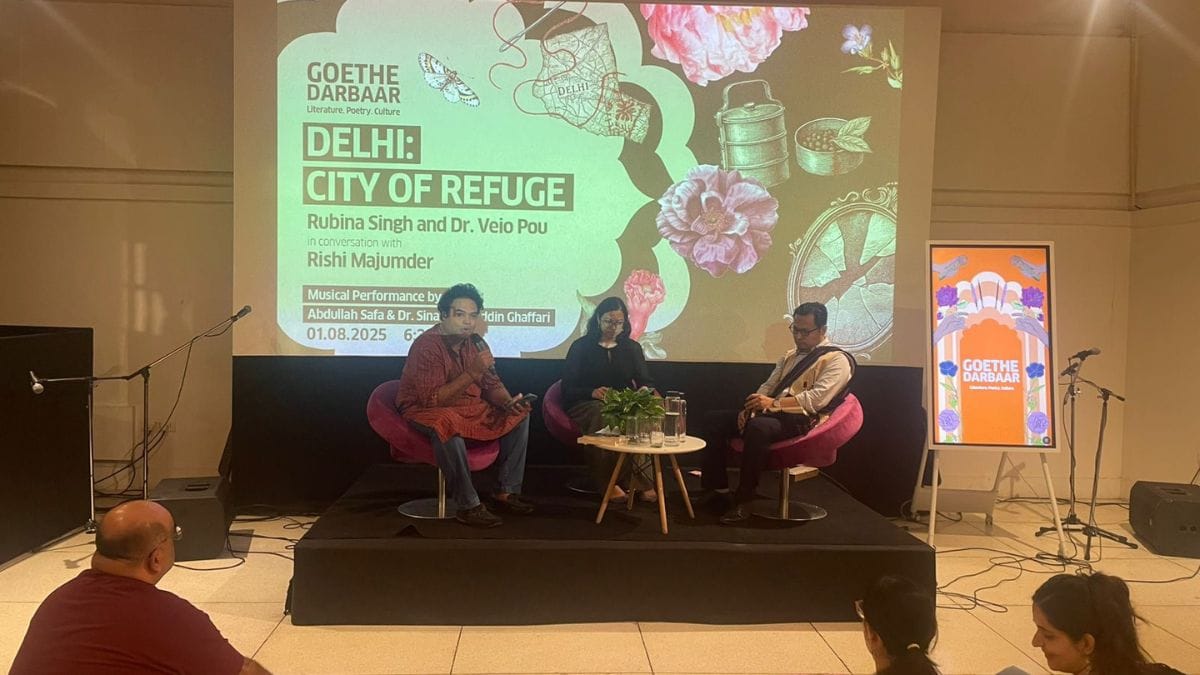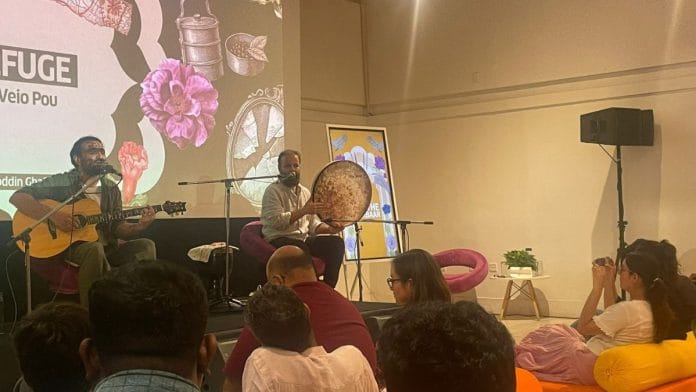New Delhi: Soft guitar chords blend with rhythmic beats from the daf, a large, circular frame drum. Two artists, one from Afghanistan and the other from Iran, recite poetry written and inspired by the 13th-century Sufi mystic Rumi. Both artists have found refuge in Delhi, and the city’s welcoming spirit was celebrated at the Goethe Institut on 1 August.
“India is not just a second home, it’s a mirror,” said Abdullah Safa, the Afghanistan-born guitar player who moved to India 15 years ago. “The culture, music and poetry that is played in Afghanistan is reflected here, and I see it everywhere. Thank you for making this place a home for us.”
After a long summer hiatus, the 18th edition of Goethe Darbaar kicked off with a musical performance. The evening’s theme – Delhi: City of Refuge – attracted a diverse audience. The young bent their knees and bodies, lounging on orange and yellow mattresses and pillows. The old opted for the more formal seating at the back.
The musical performance was followed by a panel discussion on the city’s influence on art and literature, moderated by journalist Rishi Majumder. Artist Rubina Singh from Chandigarh and author Dr. Veio Pou from Manipur discussed their work and reflected on their journeys to Delhi – what first drew them to the city and how it has shaped their lives since.
“Delhi is unquestionably my home. I have spent more than half my lifetime here,” said Pou, boldly claiming that he is now a ‘Delhiite’. “Delhi has been the place where I have found a sense of belonging. I feel like an outsider when I go back to the small town in Manipur where I am from.”
Iran to Delhi
Safa’s partner, Dr. Sina Fakhroodin Ghaffari, held his mystical instrument patiently while Safa was introducing himself. Ghaffari, who moved to India 23 years ago from Iran, was named after Mount Sinai in Egypt, after his mother’s love for the North African country.
“India is known for embracing people – that’s how the land is, how the people are,” said Ghaffari, whose father moved to India to teach art, but is now back in Iran. “My uncle, who was teaching me music, told me not to come back if I didn’t learn the sitar.”
Ghaffari ended up getting a PhD in Hindustani classical music instead and didn’t move back. But as a child, he questioned his father’s decision to move to India as opposed to the UK, Austria, or any of the other countries that offered him a job.
“He told me he didn’t want to take his family to a place where they don’t feel at home. And that really changed my life – I have never felt like I lived abroad,” said Ghaffari. “There is so much in common – in food, language, culture and the warmth of people.”
As the music wafted through the room, the audience gently moved their bodies to the melodies. At one point, Safi requested the reverb to be lowered, jokingly adding that he was “sounding like a prophet”.
Midway through the performance, Ghaffari took out a Tombak, a goblet-shaped Iranian drum. He expertly drummed his fingers in quick succession, creating a beat with crests and troughs. The guitar slowly came in, only a few chords at first, before expertly merging with the drum beat and drawing immediate applause from the audience.
The last and most popular song of the night incorporated audience claps, staggered to the chords of the guitar. The moment Safi named the song, two young audience members at the front immediately sat upright, excited that they were listening to it live. With the foreign instruments and songs, bolster pillows placed on mattresses, the room at the Goethe Institut was momentarily transformed into an intimate teahouse in Tehran or Kabul.
Also read: Khusrau came from Delhi’s high society unlike Hazrat Nizamuddin. It didn’t change their bond
Sense of belonging

Pou, an associate professor in the Department of English, University of Delhi, found his way to the city at the turn of the century. His debut novel, Waiting for the Dust to Settle, won the Gordon Graham Prize for Naga Literature in 2021.
“One of the reasons I came to Delhi was for education. In that sense, there is a pull factor,” said Pou, adding that there were no good higher education institutions available where he was from. “There is also a push factor. I grew up in the ’80s when the political situation wasn’t good in Manipur, Nagaland.”
Pou also read from some of his work, touching upon the sense of belonging he alluded to at the beginning of the discussion.
“I never felt fear the way I did living in the largely migrant city of Delhi. Somehow, the cosmopolitan space creates an atmosphere of living on the edge,” he read aloud.
When introducing Rubina Singh, a textile artist and social designer, moderator Rishi Majumder pointed out that her art was full of hard-hitting political messages, comparing it to the mysterious street artist Banksy’s work. He went on to ask her about how her art reflected the history of the city.
“Delhi is the center of so much harm that happens, but also the center of a lot of good,” said Singh, adding that she found her voice through art during the tumultuous motions of the city. “Whether it was the farmer’s protest, Covid or the CAA / NRC protests, art for me became a way of processing that for myself and sharing it with others.”
Singh first moved to Delhi in 2010 but left in six months. She found her way again to the city in 2015, and stayed for ‘love, friendship and family’, eventually also bringing her parents to Delhi from Chandigarh.
“Even though I found my language here, I didn’t find my people here,” she said, adding that it took her time to settle, but resonated with Pou that she eventually felt like an outsider when visiting Chandigarh. “Art for me became a sense of refuge. Being in Delhi and sharing that with others is what kept me here.”
(Edited by Ratan Priya)






